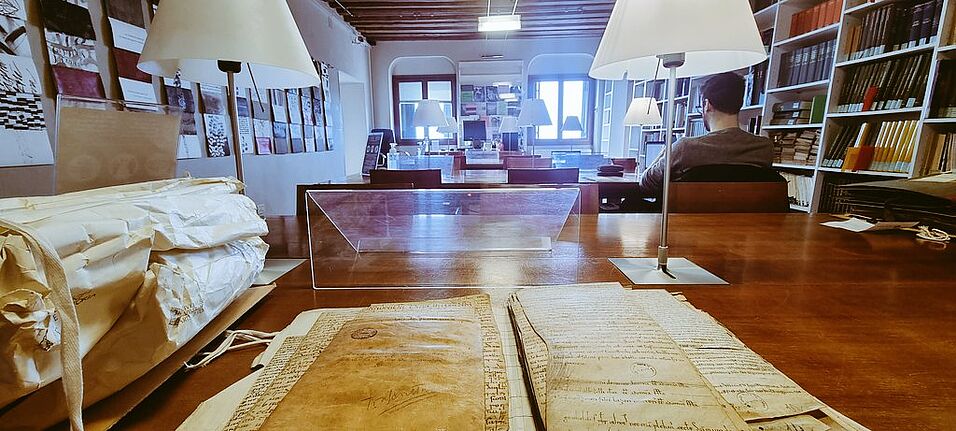One of my main tasks within the project has been to create a database of 11th-century Italian manuscripts, with a primary focus on notary documents enacted in the Patriarchate of Aquileia and in the Republic of Venice. At the moment these sources number 190, of which 43 are original 11th-century documents. As the first step toward a comprehensive list of archival sources surviving either in original or in copy, I have carried out exploratory research in the State Archives of Venice and in the State Archives of Udine. Now, the turn is on the lesser-known or completely forgotten collections across the area of the Upper Adriatic.
The Library of the Correr Museum in Venice represents a long-forgotten collection for medievalists. Its archival units also comprise medieval documents either in copy or in original, ranging between the eleventh and the fifteenth centuries. Among them, the manuscript collection of the erudite Emmanuele Antonio Cicogna (1789-1868) deserves special mention. During his lifetime Cicogna had gathered almost 4000 manuscripts which he consequently donated to the Museum. Their content, indexed by the scholar himself, is available in the form of a handwritten card catalogue supplemented by two digitized registers. Another archival unit of great interest is the so-called Fondo Provenienze Diverse, which contains the manuscripts acquired by the Museum or donated to it by private individuals. So far, I have succeeded in singling out three original notary sources and several copies or short descriptions of documents. These sources will serve as the basis for an in-depth scientific paper, tentatively scheduled by the end of the calendar year, and entitled Re-evaluating the Short Eleventh Century in the Patriarchate of Aquileia and in the Republic of Venice, 1000-1096. In this, I will address the question of eleventh-century Italy as historical problem, present and analyze the available archival material with an emphasis on the newly discovered sources. Finally, the article will conclude with an interdisciplinary evaluation of the ways the archival material has been interpreted by historians, art historians and archeologists.
Another task of mine is to contribute to the methodological development of the project. Thus, I have been working on a scientific article, entitled Social Networks in Medieval and Renaissance Studies. Thirty Years after “Robust Action” to be submitted to a leading academic journal by the end of this academic year. It has been thirty years since the publication of my long-time mentor John F. Padgett’s and Christopher K. Ansell’s groundbreaking article, entitled Robust Action and the Rise of the Medici, 1400-1434 (American Journal of Sociology, 1993) which introduced the network approach into medieval and Renaissance studies. The purpose of my present article is to bring more clarity into historians’ understanding of this path of approximately thirty years, to analyze the major concepts and trends of social network research in medieval and Renaissance studies and to ask the question of what the future might hold for the study of social networks in the field. Within this last section, I will present case studies of projects measuring social networks at various scales: urban, regional, European, and global. This latter one will specifically refer to the RELEVEN project.
I am also organizing an international workshop on the same theme which will bring together some of the most innovative historical projects of the field with a focus on medieval and Renaissance studies to examine where the research on networks stands today. The event will see the participation of some of the leading scholars in the fields of medieval history and of social sciences, including Giuseppe Albertoni (UniTrento), our project leader Tara L. Andrews, Maria Elena Cortese (UniGenoa), our dean Christina Lutter, our departmental colleague John Giebfried, John F. Padgett (UChicago), Balázs Vedres (CEU), David Zbìral (MasarykUni) and myself. The workshop will be held on the 22nd of June at the Department of History, University of Vienna. Registration information as well as the final program will be available in April.

